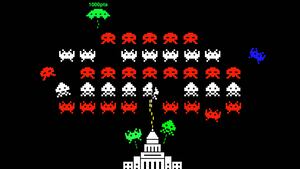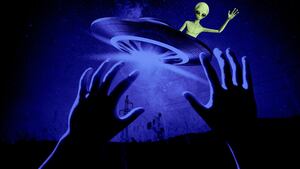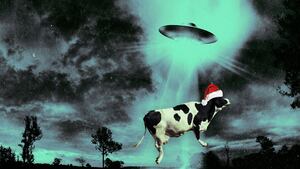NASA doesn’t know what UFOs are—but it knows most of them aren't aliens.
As for the rest of the unidentified anomalous phenomena (UAP)… who knows? “There’s missing data,” David Spergel, the chair of a new NASA study into UAPs, told reporters Thursday.
Gathering that data is the space agency’s first task as it moves to make UAP research a top priority alongside space exploration, aeronautics, and Earth science, Spergel and other top NASA officials said when they rolled out the UAP report Thursday morning.
The trick is gathering data that’s scientifically useful. That means fewer frantic emails from someone claiming their late uncle once saw something weird—an example Spergel cited from his own inbox—and more formal reports from astronomers and pilots, and even everyday people using apps that embed high-quality metadata in photos and videos of strange objects flitting around the sky.
“We want to shift the conversation about UAPs from sensationalism to science,” NASA administrator Bill Nelson said at the press conference.
That shift begins with appreciating the size of the universe. Nelson said he asked NASA scientists to estimate how many planets there are that are warm, wet, and rocky—like Earth—and that, also like Earth, could evolve life. “A trillion,” is the response he said he got.
“Do I believe in a universe that’s so vast that there could be a replication of life on Earth?” Nelson asked rhetorically. “Of course I do.”
However, that doesn’t mean aliens have visited Earth. Or that their method of visiting Earth is to tease us with fleeting glimpses of their spaceships as they buzz U.S. Navy pilots or fly in formation over major cities in the dead of night.
The 17 members of the study team that produced Thursday’s report—a mix of astronomers, aviation experts and tech experts—dismissed many of the most famous recent UAP sightings as sensor glitches, weather phenomena, airplanes, satellites or balloons.
One video of a strange-looking flying object, captured by a U.S. Air Force drone over South Asia in January, turned out to be an airliner that only looked strange because of the pixelation resulting from the video compression in the drone’s camera.
NASA’s All-Domain Anomaly Resolution Office, which scrutinizes UAP sightings, was able to explain the January UAP sighting because military drones capture data-rich, repeatable imagery. Operators know exactly where the drones are, and often steer their drones along the same routes, recording similar videos with identical cameras.
Needle In a Haystack
That doesn’t mean that NASA is completely closing the doors on ET visitors, though. It’s that absence of precise, repeatable data that keeps many UAP in the “unidentified” column. That’s a solvable problem, however—and the space agency wants to be a big part of the solution. “NASA’s expertise should be comprehensively leveraged as part of a robust and systematic data acquisition strategy,” the report urged.
It starts with better characterizing Earth and Earth technology, Spergel explained. If you’re looking for a needle in a haystack, “either you know exactly what the needle looks like … or you know what hay looks like,” he said. Since we don’t know how aliens might design a spacecraft (the “needle”) we can start by understanding everything that we can say for sure isn’t an alien spacecraft (the “hay”).
That way, when we see something we can’t explain, we can at least rule out everything we can explain—and get closer to an accurate description of possible alien craft. For NASA, that means combining weather and climate data from its own Earth-observation satellites to build a detailed model of past, present, and future atmospheric conditions.
“Thus, NASA can help determine whether specific environmental factors are associated with reported UAP properties or occurrences,” according to the report. For example, we could start ruling out every UAP sighting that’s really just a high-altitude cloud formation or a flicker of the Northern Lights.
To be clear, that’s probably a lot of them. “UFOlogy is a study of atmospheric phenomena,” John Gertz, a former chairman of the Search for Extraterrestrial Intelligence (SETI) Institute in California, which listens for radio signals from alien civilizations, told The Daily Beast.
Next, for UAP sightings in U.S. airspace, NASA could coordinate data-collection from hundreds of powerful weather and air-traffic-control satellites and radars belonging to the Federal Aviation Administration, the National Weather Service, the National Oceanic and Atmospheric Administration, and the Air Force.
These agencies’ sensors “will be essential for distinguishing interesting objects from airborne clutter,” the report said.
At the same time, the report’s authors urged NASA to fold non-government initiatives into its wider effort to understand the sky and all the strange things we see in it. The agency’s new UAP report “applauds the efforts undertaken in the private sector and U.S. academic community to employ one or more inexpensive ground-based sensors that are capable of surveying large areas of the sky.”
That’s a clear reference to UAP-recording smartphone apps, and also to Harvard physicist Avi Loeb’s Galileo Project, which is slowly installing a potentially global network of rooftop sensors—cameras, radars and microphones—to continuously record enough of the sky to characterize many of the lights, soundsm and weird objects that fill it. It’s an effort to both describe the “hay” and record possible glimpses of the “needle.”
The Galileo Project is just a few years old and only has one full sensor suite in place, in Massachusetts. But it’s already filling racks of servers with useful imagery. “We already have more data than in all UAP reports of the past,” Loeb told The Daily Beast.
Loeb said he appreciated the NASA report’s oblique reference to his sensor project. “But they could have mentioned us by name,” he quipped.
People Power
People are sensors, too—especially pilots. The FAA and Defense Department oversee thousands of them. NASA should help the Pentagon and the FAA get on the same page: reassure military and civilian pilots that there’s no shame in admitting to seeing weird flying objects, and give them a standardized way of reporting sightings that includes all the most important data.
Then there’s the general public, the real wild card in the UAP game. Intense public interest in UAPs is what’s driving the renewed government focus on the phenomenon. That same intensity is a huge problem for actual scientists trying to apply actual science to the problem of unidentified flying objects.
The authors of the NASA study were harassed online, Spergel said. The harassment got so bad that, when NASA recently appointed a new director of UAP research, the agency decided not to release his name. “Some of the threats and harassment have been beyond the pale,” Daniel Evans, NASA’s assistant deputy associate administrator for research, told reporters Thursday.
Probably only a minority of UAP-enthusiasts are dangerous online trolls. The enthusiastic majority could be an asset as NASA widens its UAP research. There are smartphone apps—including one from New York City-based Enigma Labs—that add precise metadata to photos and videos, and correlate separate imagery of the same object specifically for the purpose of adding scientific rigor to UAP sightings by everyday people.
“The panel also sees several advantages to augmenting potential data collection efforts using modern crowdsourcing techniques, including open-source smartphone-based apps that simultaneously gather imaging data and other smartphone sensor data from multiple citizen observers,” the report explained, adding that NASA should even consider acquiring one of these apps.
If NASA’s latest UAP report seems like it’s full of “coulds” and “shoulds,” well, that’s because it is. The agency is just beginning to make UAP a top priority—asking the same question that was once voiced mostly by conspiracy theorists and T.V. writers: Are aliens among us?
But NASA does science—and science doesn’t presuppose the answer to a question that profound. The answer will come after a lot of study of a lot of data. Data that NASA is just beginning to gather.
“For anyone hoping that NASA would reveal little green men retrieved from a crash site, this report will be disappointing,” Douglas Vakoch, the president of Messaging to Extra-Terrestrial Intelligence International in San Francisco, told The Daily Beast. “But for anyone serious about getting to the bottom of these unexplained anomalous phenomena, this briefing gives concrete guidelines for taking action to solve one of the greatest mysteries of the past century.”
The public should be patient, NASA administrator Nelson said. “We don’t know what these UAP are, but we’re going to find out.”










